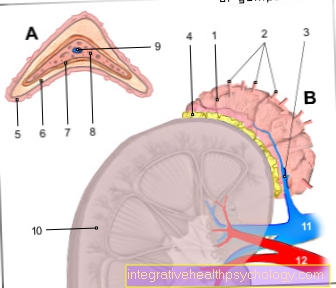Tumor in the abdomen - what does it include?
What is a tumor in the abdomen?
A tumor in general is initially only understood to be a swelling or a mass that is independent of its origin. This includes not only tumors, but also cysts, inflammatory swellings or edema, i.e. water retention.
In addition, a tumor can be both benign and malignant in nature; a general statement on this cannot be made by simply specifying the term “tumor”. A tumor in the abdominal cavity can therefore also be numerous and different in nature and in principle arise from every organ located in the abdominal cavity.

What tumors are there in the abdomen?
Tumors in the abdominal cavity can have different origins, and every organ in the abdominal cavity can in principle produce a tumor - both benign and malignant. The organs located in the abdominal cavity include the stomach, the small and large intestines, the liver, the gall bladder, the pancreas, the kidneys and adrenal glands, the two ureters and the spleen. Each organ mentioned here can - depending on the respective tissue composition - produce different and also several types of tumors. Possible benign tumors include, for example, papillomas and adenomas (originating from surface cells = epithelium), fibromas (originating from connective tissue cells), lipomas (originating from fat cells), leiomyomas (originating from cells of the smooth muscles) or rhabdomyomas (originating from cells from the striated skeletal muscles ).
Malignant tumors, on the other hand, refer to adenocarcinomas, squamous cell carcinomas, carcinoids (as an example of neuroendocrine tumors), fibrosarcomas, liposarcomas, leiomyosarcomas and rhabdomyosarcomas.
These symptoms could indicate a tumor in the abdomen
Depending on which organ is affected by the tumor or which organ is causing the tumor, the symptoms can also be different. As a rule, benign tumors do not grow aggressively but slowly and do not destroy the original organ, so that these often only become noticeable after a long period of time, when they press on other organs due to their increase in size or even become visible from the outside through protrusions in the abdominal area. This often leads to symptoms such as pain, a feeling of pressure in the abdomen, changes in the stool such as constipation and urinary retention.
Malignant tumors, on the other hand, grow faster and more aggressively, so that they often lead to a change and destruction of the original tissue, until they ultimately even break into the vascular or lymphatic system and form metastases. They usually become noticeable through a loss of the actual function of the affected organ, abnormal organ-specific blood values (e.g. liver values, kidney values, etc.) or through symptoms caused by metastases. These include e.g. Bone pain, neurological abnormalities, and deterioration in liver or lung function.
Water in the stomach
Water in the abdomen, also called ascites, is a pathological accumulation of fluid in the abdominal cavity, which can have different causes. A distinction is made between non-flammable water (Transudate) in the context of a protein deficiency or increased pressure in the venous abdominal vessels (e.g. in liver cirrhosis or heart failure) from inflammatory water (Exudate), for example in the case of tumors or inflammation of structures in the abdominal cavity. In the case of the latter, the tumorous or inflammatory process causes a leak in the vessel walls, so that fluid from the blood can leak into the abdominal cavity. Certain diseases can also lead to bloody (hemorrhagic ascites), lymph-containing (chylous ascites) or bile-containing ascites (biliary ascites) come.
More about this topic can be found: Water in the stomach
Peritoneum metastases
Peritoneal metastasis, also called peritoneal carcinosis, describes the infestation of the peritoneum (peritoneum) with malignant tumor cells, usually originating from a malignant tumor in the abdomen. In most cases, these are advanced tumors of the gastrointestinal tract, the pancreas or the ovaries.
Rarely, however, cancer of the peritoneum may develop, which is then not a manifestation of metastases from a tumor in the abdomen, but rather originates primarily in the peritoneum itself (e.g. mesothelioma of the peritoneum). Peritoneal metastases are usually noticeable in that they lead to abdominal pain and changes in the stool (mostly constipation), albeit relatively late. As the tumor mass increases, peritoneal carcinosis can lead to functional impairments in various organs that are surrounded by the peritoneum in the abdomen. This can be, for example, urinary retention, intestinal obstruction, liver dysfunction, but also the development of ascites.
For more information, see: Peritoneum metastases
Diagnosis of tumors in the abdomen
The diagnosis of tumors in the abdominal cavity sometimes varies considerably, as every tumor can have a certain characteristic, which can sometimes be more or less well represented by different methods. In addition to the determination of certain blood values - so-called tumor markers - there are also some imaging methods available in the laboratory, such as the ultrasound examination (Sonography), endoscopy and endosonography, computed tomography (CT), magnetic resonance imaging (MRI, magnetic resonance), scintigraphy and positron emission tomography (PET).
Further information on the above You can get diagnostic options at: Diagnostics - all procedures simply explained!
Treatment of tumors in the abdomen
There is no generally applicable therapy method for tumors in the abdominal cavity, since different therapeutic approaches are pursued for each type of tumor in the abdomen. In addition, the therapy is also largely dependent on whether it is a benign or malignant tumor and which tumor stage the patient is in when he first becomes conspicuous with the respective disease.
In principle, curative, i.e. healing, therapeutic approaches can be distinguished from palliative, i.e. soothing. In both cases, different treatment measures have to be taken, which include, for example, the surgical removal of the tumor, the administration of chemotherapeutic agents or other drugs and / or the implementation of radiation.
Which method or which method combinations are used is usually determined and recommended after a final review of all examination results as part of an in-house tumor conference.
Life expectancy for tumors in the abdomen
An indication of the life expectancy in the case of a tumor in the abdominal cavity cannot be given across the board, as this depends on many different factors. These include, on the one hand, whether it is a benign or malignant tumor, and on the other hand, what type of tumor (i.e. from which tissue it originates), as well as the tumor size or tumor extent, the tumor differentiation (grade cell degeneration) and metastasis (lymph node involvement or distant metastases in other organs).
An overview of the tumor disease can only be obtained through a synopsis of many test results, but even then, information about life expectancy must often be viewed with caution.
It can not only vary individually (e.g. due to the basic physical condition of the patient concerned), but is sometimes also dependent on the respective therapy options for the respective tumor disease.















.jpg)













